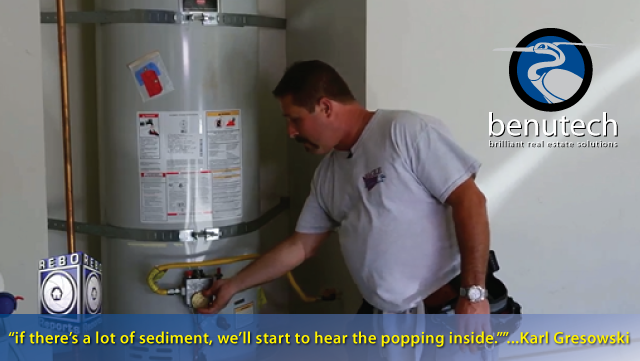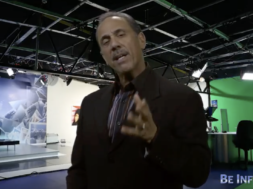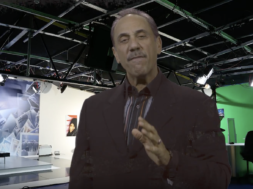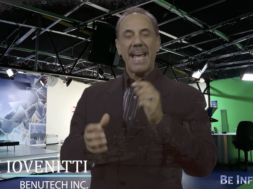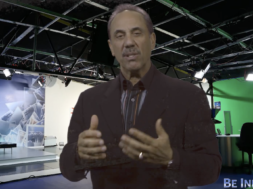A whole video on what home inspectors look at when inspecting water heaters? Absolutely! Not only is a working hot water heater an expected amenity in modern society, but there are also plenty of ways that one could cause problems. In this video, Eagle Home Inspector Karl Gresowski guides us through the ins and outs of the water heater, not only testing for heat, but also listening for sediments, tugging for earthquake security, measuring the proximity of the drain pan to the unit, and otherwise putting it through its paces.
KARL GRESOWSKI: Yes, well, what we’re going to do is we want to make sure the water heaters have two seismic straps, and that they’re nice and tight so that we don’t have any earthquake problems. Want to make sure it’s nice and secure. We also want to make sure that we have the proper gas line on there, that it’s not an aluminum, that it’s all updated, and then make sure we’re not leaking gas from anywhere. We also have the temperature/pressure valve up on top with the pipe that drains to the exterior. It’s very crucial that we have one of those so that if it does overheat, the water can get spilled off and taken out and relieve the pressure. As you notice, new code, we have a proper drain pan installed, with a drain line that drains down to the garage floor in case it rusts out and leaks.
IOVENITTI: So, when you’re looking at a water heater, I mean, is there ways for you to tell the age of a water heater, whether or not there’s a lot of sediment…
GRESOWSKI: Well, usually what happens is I’ll kick it on high when I get here, and I’ll start running the interior plumbing. What happens if there’s a lot of sediment, we’ll start to hear the popping inside. Usually, water heaters should be drained and flushed once a year to make sure we get the hard sediment out of it.
IOVENITTI: Well, that’s interesting. So, you actually drain it, you shut off the valves, drain it, and then fill it back up again, drain it.
GRESOWSKI: Yes, what happens is we’ll turn off the main valve on top. We will open the temperature pressure valve on top that has that little metal bar up there, you open it up to allow the air to siphon as we hook up the hose and drain it. So once it’s completely drained, we will turn on the water and let it run for about 45 minutes where the water’s coming down, hitting the bottom, and trying to push the sediment out. Once that happens for about 45 minutes, we can go ahead and seal it back up and restart it.
IOVENITTI: So when your inspection, is that something that you could check?
GRESOWSKI: We can’t check for sediment. I do listen for the pop.
IOVENITTI: I see.
GRESOWSKI: And if I start to hear, or I don’t see a handyman or contractor’s listed the last time it was flushed, we will recommend it to be flushed or serviced.
IOVENITTI: Now, is there a code for the attachment of that water heater to the home itself?
GRESOWSKI: No, there’s not. We do have the model and serial number. The builders usually do not label that inside there for each house.
IOVENITTI: And how about the strapping?
GRESOWSKI: The strapping is bought from Home Depot or the local plumbing shop, which is tied in and lag bolted into studs. And that’s very important. A lot of guys will use wood screws. Wood screws are not proper. We actually have to lag bolt the bolt into a stud to make sure it’s tight so if the water tank moves, it’s not going to be pulled out of the wall.
IOVENITTI: I see. Is there anything else in the water heater area that we should be concerned about?
GRESOWSKI: Well, up on top you can tell the pipes are insulated, so when it gets cold, they can keep it from freezing. Out here in California, it’s not really required, because we don’t get a lot of freezing temperatures out here. Our main thing is our bent pipe, and the draft diverter on top. We want to make sure that those are connected properly, that we’re not leaking any carbon monoxide.
IOVENITTI: I see. So, the gas lines coming into the unit itself, as long as the proper flex tube is there you consider it to be a good installation?
GRESOWSKI: Exactly. And we want to make sure there’s play. We don’t want it so tight that if the earth moves that it’s going to cause it to break and cause a gas leak. So we don’t want excess, but we do want enough to move in case something does move with earthquakes.
[music]IOVENITTI: Now you might think that’s our exit music, but that wasn’t.
[both laugh]IOVENITTI: Cell phones going off, it’s normal, it happens all the time. So, tell us anything else that we need to know on this unit itself.
GRESOWSKI: As you notice, the drain pan should always be two inches bigger than the unit all the way around for the water heater, because you’ve got to remember, we’ve got the drain hose bib, and usually these will rot out and start to leak. And if the drain pan’s too close, then we’re going to damage the drywall. So we want to make sure we have proper clearance around it, that it will drain, and that these are running down to the ground so at least it’s going to drain down, not ruin our drywall.
IOVENITTI: Well, thank you for telling us all about that. I mean, it’s some of the things that I wouldn’t know, as being a real estate agent, what to look for. But it also tells us when you’re doing a visual inspection what kind of things that you should be kind of… I mean, just doing a visual inspection yourself, what sort of things you should be looking for in order to do a pre-inspection. And if you understand these things more thoroughly, it’ll help offset litigation and your failure to disclose. So hiring a home inspector, the right home inspector, can give you at least an overview of the home that will give you kind of an idea of what you’re in for when you buy it and when you sell it. My way of doing things has always been to have the home inspection done first. I always thought that as a seller you should have that done so that you have a kind of a knowledge of what’s going on so that you can have it fixed prior to having anyone else come in to get it done. So, have you done a lot of seller inspections?
GRESOWSKI: Yeah, I do pre-inspections, probably one or two a week. They want to get ready to sell it, they want to get most of the stuff handled. That way, when another inspector comes through and inspects it, it’s all been handled. The improper wiring, make sure there’s no leaking under the sinks, that those things are handled, so that the house will go more smoothly
IOVENITTI: It’s kind of a precautionary way to make sure the home, if you do have somebody that you’re unfamiliar with, and maybe not as great as Karl coming in and inspecting the home, that you have some way of assuring yourself that things will be done correctly. Anyway, this is Tom Iovenitti. Thank you, Karl, thanks so much for your time going through the house with us. We really appreciate that. Stay tuned for more on home inspections from time to time, because we’re going to visit Karl down in the Carlsbad area and some other inspectors around the nation, so stay tuned. This is Tom Iovenitti with ReboReports from Benutech Incorporated. Thanks for watching.





